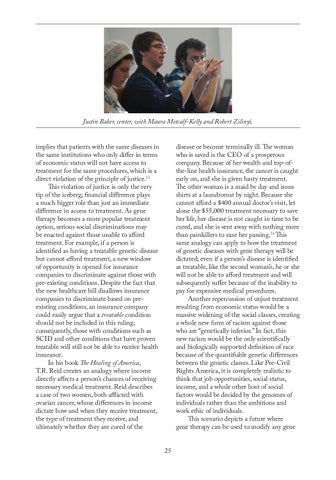Justin Baker, center, with Maura Metcalf-Kelly and Robert Zilinyi. implies that patients with the same diseases in the same institutions who only differ in terms of economic status will not have access to treatment for the same procedures, which is a direct violation of the principle of justice.13 This violation of justice is only the very tip of the iceberg; financial difference plays a much bigger role than just an immediate difference in access to treatment. As gene therapy becomes a more popular treatment option, serious social discriminations may be enacted against those unable to afford treatment. For example, if a person is identified as having a treatable genetic disease but cannot afford treatment, a new window of opportunity is opened for insurance companies to discriminate against those with pre-existing conditions. Despite the fact that the new healthcare bill disallows insurance companies to discriminate based on preexisting conditions, an insurance company could easily argue that a treatable condition should not be included in this ruling; consequently, those with conditions such as SCID and other conditions that have proven treatable will still not be able to receive health insurance. In his book The Healing of America, T.R. Reid creates an analogy where income directly affects a person’s chances of receiving necessary medical treatment. Reid describes a case of two women, both afflicted with ovarian cancer, whose differences in income dictate how and when they receive treatment, the type of treatment they receive, and ultimately whether they are cured of the
disease or become terminally ill. The woman who is saved is the CEO of a prosperous company. Because of her wealth and top-ofthe-line health insurance, the cancer is caught early on, and she is given hasty treatment. The other woman is a maid by day and irons shirts at a laundromat by night. Because she cannot afford a $400 annual doctor’s visit, let alone the $55,000 treatment necessary to save her life, her disease is not caught in time to be cured, and she is sent away with nothing more than painkillers to ease her passing.14 This same analogy can apply to how the treatment of genetic diseases with gene therapy will be dictated; even if a person’s disease is identified as treatable, like the second woman’s, he or she will not be able to afford treatment and will subsequently suffer because of the inability to pay for expensive medical procedures. Another repercussion of unjust treatment resulting from economic status would be a massive widening of the social classes, creating a whole new form of racism against those who are “genetically inferior.” In fact, this new racism would be the only scientifically and biologically supported definition of race because of the quantifiable genetic differences between the genetic classes. Like Pre-Civil Rights America, it is completely realistic to think that job opportunities, social status, income, and a whole other host of social factors would be decided by the genomes of individuals rather than the ambitions and work ethic of individuals. This scenario depicts a future where gene therapy can be used to modify any gene 25
